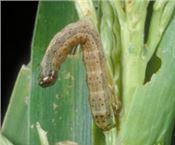Why Are My Fall Armyworms Melting?

Figure 1. Infected larvae often move upwards on the plant and eventually die and liquefy, shedding virus particles.
DR. RIC BESSIN
PRINCETON, KEN.
The have been a few reports of fall armyworm (FAW) larvae ‘melting’ on plants. This is likely due to infections of the larvae by a naturally occurring nucleopolyhedrovirus, usually referred to as an NPV.
There are many different types of NPV viruses that attack insects and most are very host-specific. The fall armyworm NPV is specific to that species, not infecting natural enemies or other insects. NPVs can spread through local populations of FAW and help to reduce their numbers. However, unlike insecticides, NPVs take time to kill susceptible insects.
FAW larvae become infected when they feed and ingest the virus. The alkaline gut of the insect releases the virus where it attacks the insect cells and replicates. Typically, infected insects will stop feeding in a few days, but the larva may not die until a week or more after feeding cessation. The smaller larvae succumb more quickly to the virus than older larvae, and the process can take longer under cooler conditions.
There is one commercial insecticide that uses a strain of the FAW NPV.
The product is Fawligen. This product needs to target small FAW larvae that are less than ½ inch in size. This insecticide specifically targets FAW and will not control other pests in the field. But unlike other insecticides, the virus will propagate in the field, extending it protection. ∆
DR. RIC BESSIN: Entomology Extension Specialist, University of Kentucky